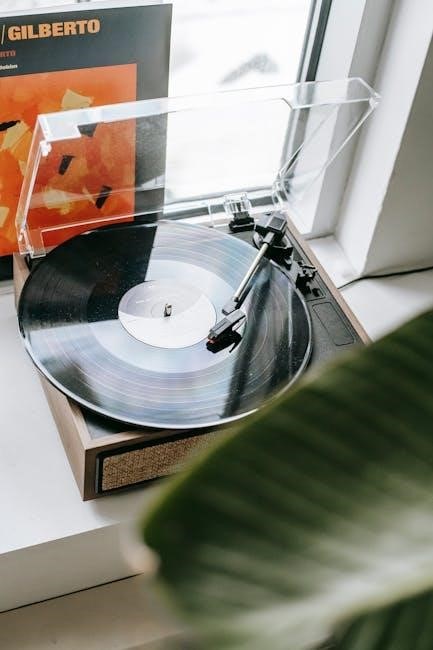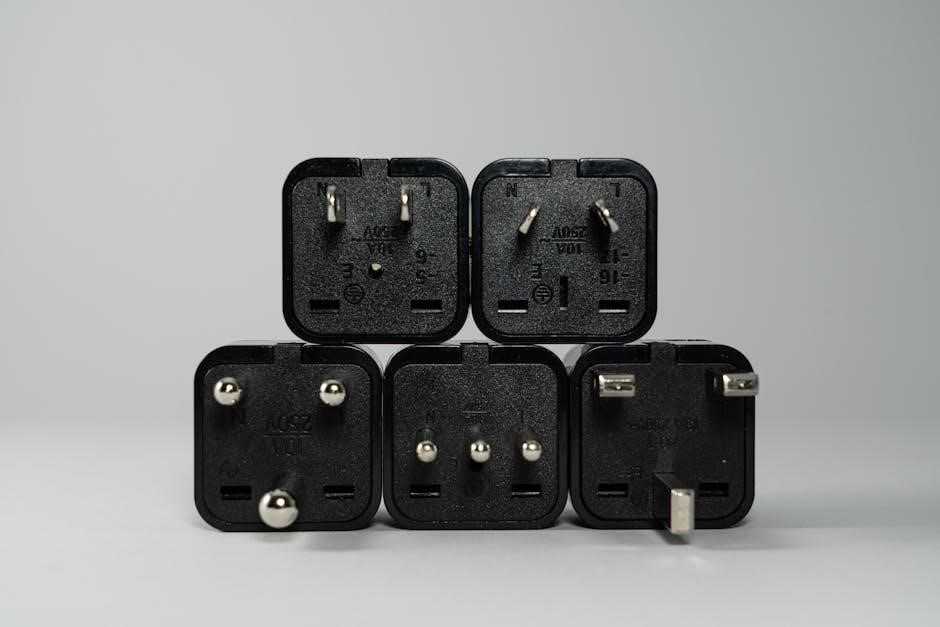
ge range lp conversion kit instructions
Converting your GE range to LP enables safe and efficient cooking, offering cost savings and reliable performance․ Proper conversion ensures safety, preventing gas leaks and hazards․ Follow the guide for a successful DIY project;
Overview of the Conversion Process
Converting a GE range to LP involves replacing natural gas orifices with LP-compatible ones and adjusting the regulator for proper gas flow․ The process requires a conversion kit, such as the GE WB28K10556 or WB28X24757, which includes orifices, fittings, and instructions․ These kits are designed for specific models and ensure compatibility․ The conversion typically starts with accessing the burner and oven orifices, removing the natural gas components, and installing the LP-specific parts․ The regulator must also be adjusted to handle the higher pressure of propane․ Safety is critical, so leak testing and flame checks are essential after the conversion․ Proper installation ensures efficient cooking performance and prevents hazards․ The process is DIY-friendly with the right tools and guidance, allowing homeowners to save on energy costs while maintaining appliance functionality․ Always follow the manufacturer’s instructions for a safe and successful conversion․
Importance of Proper Conversion for Safety and Efficiency
Proper conversion of a GE range to LP is crucial for safety and efficiency․ Incorrect conversion can lead to gas leaks, uneven flames, and potential fire hazards․ LP burns hotter than natural gas, requiring specific orifices and regulator settings to ensure proper combustion․ Using the correct conversion kit, such as the GE WB28K10556, guarantees compatibility and safe operation․ Improper installation can result in dangerous conditions, including carbon monoxide risks and appliance damage․ Efficiency is also compromised without proper conversion, as incorrect gas flow can reduce cooking performance and increase energy consumption․ Always follow the manufacturer’s instructions and perform leak tests after conversion to ensure safety․ Proper conversion not only prevents hazards but also ensures optimal appliance performance, making it a critical step for homeowners switching to LP․

Preparing for the Conversion
Gather necessary tools and materials, including the GE LP conversion kit, to ensure a smooth process․ Understand the components and their roles in the conversion to guarantee compatibility and safety․
Gathering Necessary Tools and Materials
To successfully convert your GE range to LP, gather all required tools and materials beforehand․ Essential tools include an adjustable wrench, screwdrivers, pliers, and a gas leak detector․ Ensure you have the GE LP conversion kit, which typically includes LP orifices, a regulator, and installation instructions․ Additional materials like Teflon tape or pipe dope for sealing connections are recommended․ Safety gear such as gloves and goggles should also be on hand․ Familiarize yourself with the components and their functions to avoid delays․ Proper preparation ensures a smooth and safe conversion process․ Always follow the manufacturer’s guidelines and safety precautions when handling gas appliances․ Having everything ready will help you complete the conversion efficiently and minimize potential risks․ Double-check the kit’s contents and verify compatibility with your specific GE range model․ Organize your workspace to maintain clarity and accessibility during the procedure․

Understanding the Components of the LP Conversion Kit
The LP conversion kit for your GE range is designed to ensure compatibility with propane gas․ It typically includes LP orifices, which are smaller than natural gas orifices due to propane’s higher pressure․ You’ll also find a gas regulator to control the flow of propane safely․ The kit may include adapters or fittings to connect the propane system to your range’s existing gas lines․ Detailed instructions are provided to guide you through the conversion process․ Understanding each component’s function is crucial for a successful installation․ The orifices must be correctly sized for LP gas to ensure proper burner performance․ The regulator ensures the gas pressure is within safe and efficient operating levels․ Familiarize yourself with all parts before starting the conversion․ Always verify that the kit is compatible with your specific GE range model for optimal results․ Proper installation of these components is essential for safety and performance․ Follow the instructions carefully to avoid errors․
Locating the Model Number and Compatibility Check
To begin the LP conversion process, you must locate the model number of your GE range․ This number is usually found on a data plate or label, often located on the bottom of the range, behind the lower drawer, or on the back of the unit․ It may also be printed on the sides or near the serial number․ Once you have the model number, verify its compatibility with the LP conversion kit․ GE provides specific kits for different models, and using the wrong kit can lead to safety hazards or poor performance․ Check the official GE website, the user manual, or the packaging of the conversion kit for a list of compatible models․ Ensure the kit is designed for your range’s specific configuration, such as its size, fuel type, and burner layout․ Accurate model identification is critical for a safe and successful conversion․ Always double-check the compatibility before proceeding;

Converting the Range to LP
Converting your GE range to LP involves a series of precise steps to ensure safety and functionality․ This process requires careful preparation and adherence to the manufacturer’s instructions for optimal results․
Step-by-Step Instructions for Converting Burners

To convert your GE range burners to LP, start by turning off the gas supply and disconnecting the gas line using an adjustable wrench․ Remove the burner caps and grates to access the burner orifices․ Replace the natural gas orifices with the LP-compatible ones provided in the conversion kit, ensuring they are securely installed․ Adjust the burner air shutters to optimize the airflow for LP gas combustion․ Reassemble the burners and reconnect the gas line․ Turn the gas supply back on and test each burner to ensure a steady, even flame․ If the flame appears yellow or uneven, check the air shutter adjustments․ Properly installed LP burners will provide efficient and safe performance for your range․
Converting the Oven and Broiler for LP Compatibility
Converting the oven and broiler to LP compatibility involves specific adjustments to ensure proper combustion․ Start by locating the burner orifices, typically found near the burner assembly․ Replace the existing orifices with LP-compatible ones from the conversion kit, using tools like an adjustable wrench or screwdriver as needed․ Consult the user manual or a diagram for precise locations․ After installation, adjust the burner air shutters to optimize airflow for LP gas, ensuring efficient combustion․ Conduct a test by lighting the oven and broiler to check for steady, blue flames․ If flames appear yellow or uneven, further adjust the air shutters․ Perform a leak test using dish soap and water on connections to detect any gas leaks․ Follow all safety precautions, such as turning off the gas supply before starting․ Finally, test the oven and broiler performance with a trial bake or broil to confirm everything functions correctly․ Keep original parts labeled and stored for potential future use․ By following these steps carefully and taking necessary safety measures, the conversion can be completed effectively․
Adjusting the Regulator for Proper Gas Flow
Adjusting the regulator is a critical step to ensure safe and efficient operation after converting your GE range to LP․ Locate the regulator, typically found near the gas inlet or on the side of the range․ Turn off the gas supply at the main valve before proceeding․ Remove the regulator cap and use an Allen wrench to turn the adjustment screw clockwise or counterclockwise․ Clockwise reduces gas flow, while counterclockwise increases it․ Refer to the conversion kit instructions for the recommended setting․ Replace the cap securely after adjustment․ Turn the gas supply back on and test the burners and oven to ensure proper flame appearance․ If the flames are too high or low, fine-tune the regulator accordingly․ Proper adjustment ensures efficient combustion and prevents issues like yellow flames or inconsistent heat․ Always follow safety guidelines and avoid over-tightening, which could damage the regulator․ If unsure, consult the GE manual or contact a professional for assistance․ This step is essential for optimal performance and safety․
Replacing the Orifices with LP-Compatible Ones
Replacing the orifices is a crucial part of the GE range LP conversion process․ LP gas requires different orifice sizes compared to natural gas to ensure proper combustion․ Start by turning off the gas supply and disconnecting power to the range for safety․ Remove the burners and access the orifices, typically located at the base of the burners or in the gas supply lines․ Use a wrench or socket to remove the existing orifices and discard them․ Install the LP-compatible orifices provided in the conversion kit, ensuring they are securely tightened․ Reassemble the burners and reconnect the gas supply․Refer to the kit’s instructions for specific orifice sizes and locations, as they may vary by model․ After installation, test the burners and oven to ensure proper flame color and performance․ Incorrect orifice sizing can lead to inefficient burning or safety hazards, so accuracy is key․ This step ensures optimal gas flow and combustion for LP operation․ Always follow the manufacturer’s guidelines for this procedure․ Proper installation is essential for safety and efficiency․ If unsure, consult a professional for assistance․

Testing the Conversion
Testing the conversion ensures safety and efficiency․ Check for leaks, verify proper flame appearance, and confirm all burners and oven function correctly․ Consult the GE manual for specific testing instructions and guidelines․
Leak Testing the System After Conversion
Leak testing is critical after converting your GE range to LP․ Use a gas leak detector or a mixture of dish soap and water to inspect all connections․ Apply the solution to the regulator, hoses, and valve connections․ Bubbles forming indicate leaks․ Tighten connections or replace faulty parts if issues arise․ Ensure the regulator, burner orifices, and oven connections are thoroughly checked․ Refer to the GE manual for specific leak-testing procedures․ Proper testing ensures safety and prevents potential gas hazards․ Always verify that all components are secure and functioning correctly before using the range․ Failure to perform leak testing can lead to safety risks or inefficient operation․ Take your time to inspect every connection meticulously․
Ensuring Proper Flame Appearance and Performance
After converting your GE range to LP, it’s essential to verify the flame appearance and performance․ A proper LP flame should be blue with a slight yellow tip, indicating complete combustion․ If the flame appears yellow or orange, it may signal inadequate airflow or incorrect burner adjustment․ Ensure all burners and the oven ignite smoothly and maintain a consistent flame․ Check for any signs of incomplete combustion, such as soot or a flickering flame, which could indicate improper installation or adjustment․ Adjust the air shutters as needed to achieve the ideal flame․ Test the range at different heat settings to ensure even heating and performance․ Refer to your GE manual for specific instructions on adjusting your model․ Proper flame appearance ensures safety, efficiency, and optimal cooking performance․ Always double-check the flames after conversion to prevent potential hazards and maintain reliable operation․

Troubleshooting Common Issues
Common issues after LP conversion include improper regulator adjustment, incorrect orifice installation, or gas line leaks․ Always refer to the GE manual for specific troubleshooting steps․ Ensure proper installation and adjustment for reliable operation․
Identifying and Resolving Gas Leaks
Gas leaks are a critical issue that must be addressed immediately for safety․ To identify leaks, apply a mixture of dish soap and water to gas lines, connections, and valves․ Bubbles forming indicate a leak․ Turn off the gas supply and inspect all connections, tightening any loose fittings․ If leaks persist, replace damaged or worn-out components, such as O-rings or gaskets․ Ensure all connections are secure and compatible with LP gas․ After repairs, repeat the soap test to confirm the system is leak-free․ Regular inspections and maintenance can prevent future leaks․ Always follow safety guidelines, and if unsure, consult a professional․ Properly resolving gas leaks ensures safe and efficient operation of your GE range after LP conversion․
Addressing Uneven Flames or Poor Burner Performance
Uneven flames or poor burner performance can occur after an LP conversion due to improper installation or component issues․ First, ensure the correct LP orifices are installed, as specified in the GE conversion kit instructions․ Verify that the orifices are securely seated and free from debris․ Check the burner caps for proper alignment and cleanliness, as misaligned or dirty caps can disrupt flame distribution․ Clean the burner ports to remove any food residue or blockages․ Inspect the gas regulator to ensure it’s adjusted correctly for LP gas pressure, following the manufacturer’s guidelines․ Additionally, examine the venturi tubes for obstructions and clean them if necessary․ If issues persist, inspect for any damaged or worn-out components and replace them as needed․ Finally, after making adjustments, test the burners to confirm even flame patterns and optimal performance․ Addressing these factors ensures reliable operation and safety of your LP-converted GE range․
Maintenance and Care After Conversion

Regular cleaning of burners, orifices, and vents ensures optimal performance․ Inspect and replace worn-out parts promptly․ Schedule annual professional inspections to maintain safety and efficiency․ Always follow GE’s maintenance guidelines for LP ranges․
Routine Maintenance Tips for LP-Powered Ranges
Regular maintenance is crucial for the longevity and safe operation of your LP-powered range․ Start by cleaning burner caps, grates, and orifices to ensure proper gas flow․ Use a soft brush or toothbrush to remove food particles and debris․ Check for gas leaks by applying soapy water to connections; bubbles indicate a leak․ Inspect the ignition system and ensure it’s functioning correctly․ Clean or replace spark electrodes if necessary․ Verify that all vents and ducts are unobstructed to maintain proper ventilation․ Replace worn-out LP hoses or connections promptly to prevent leaks or fires․ Schedule an annual professional inspection to ensure compliance with safety standards․ Keep the range surface clean to avoid grease buildup, which can affect performance․ Finally, always store LP tanks in a well-ventilated, upright position away from heat sources․ By following these tips, you’ll maintain safety, efficiency, and optimal performance of your LP range․
Cleaning and Inspecting the Burners and Orifices
Cleaning and inspecting the burners and orifices is essential for optimal performance and safety after converting your GE range to LP․ Begin by turning off the LP supply and allowing the range to cool completely․ Remove the burners and orifices, then use a soft-bristle brush or toothbrush to gently sweep away food particles and debris․ For stubborn grime, mix a mild detergent with warm water and use a non-abrasive scrubber, but avoid harsh chemicals that could damage the components․ Rinse thoroughly and dry with a soft cloth․ Inspect the orifices for blockages, wear, or damage; replace any damaged parts immediately․ Reassemble everything carefully, ensuring all connections are secure․ After cleaning, light the burners to check for even flames and proper function․ Regular cleaning prevents clogged burners and ensures efficient combustion․ For tough grime buildup, soak parts in warm soapy water before scrubbing․ Always follow manufacturer guidelines and consider professional assistance if unsure․

Additional Resources and Support
For detailed guidance, refer to GE’s official LP conversion manuals and support documentation․ Visit the GE Appliances website or contact their customer service for assistance․ Additional resources include authorized parts distributors․
Accessing Official GE Conversion Manuals

To access official GE conversion manuals for your range LP conversion, visit the GE Appliances website․ Navigate to the “Support” or ” Manuals & Downloads” section․ Enter your range’s model number, located on the appliance’s sticker, typically found on the back or inside a drawer․ Search for your specific model to download the LP conversion manual․ If unavailable online, contact GE’s customer service via their “Contact Us” page for assistance․ Additionally, check with authorized GE parts distributors, as they may provide access to the manual․ For further guidance, explore GE’s general LP conversion guides or FAQs․ Ensure to download PDF documents using a PDF reader․ Consider reaching out to appliance repair forums or professionals for additional support if needed․ Always prioritize reputable sources and professional help to ensure safety and accuracy in your conversion project․
Where to Find Compatible Parts and Accessories
When converting your GE range to LP, finding compatible parts is crucial․ Start by visiting the GE Appliances official website, where you can search for LP conversion kits and accessories by your range’s model number․ Authorized GE retailers like Best Buy, Home Depot, and Lowe’s often carry these kits․ Online marketplaces such as Amazon or eBay may also have compatible parts, but ensure they are verified sellers․ Additionally, check with local appliance repair shops or specialty stores that focus on gas range components․ Always verify compatibility by cross-referencing the model number and specifications․ If unsure, contact GE customer support for assistance․ Avoid using non-GE parts unless explicitly stated as compatible, as this could void your warranty or compromise safety․ Having the correct parts ensures a seamless and safe conversion process․
Final Thoughts on Successful LP Conversion
Completing the LP conversion on your GE range is a significant achievement, ensuring safety, efficiency, and optimal performance․ By adhering to the instructions and taking necessary precautions, you’ve successfully adapted your appliance to run on propane․ This conversion not only enhances functionality but also provides peace of mind knowing your range operates safely․ Regular maintenance, as outlined, will extend the lifespan of your appliance․ Remember, proper installation and annual inspections are crucial for sustained efficiency․ If unsure about any step, consulting a professional is always recommended․ The sense of accomplishment from this DIY project is rewarding, and the long-term benefits of LP conversion make it well worth the effort․ Keep your range well-maintained, and it will continue to serve you reliably for years to come․ Congratulations on successfully completing your GE range LP conversion!
Encouragement for DIY Completion of the Project
Embarking on the GE range LP conversion project is a commendable decision that showcases your DIY spirit and willingness to tackle complex tasks․ While the process may seem daunting at first, breaking it down into manageable steps makes it entirely achievable․ With the right tools and a clear understanding of the instructions, you can successfully convert your range to LP․ Remember, DIY projects like this not only save money but also foster a sense of accomplishment and confidence in your abilities․ Don’t hesitate to consult the manual or online resources if questions arise—these tools are designed to guide you․ Take pride in knowing that your effort will result in a safer, more efficient appliance tailored to your needs․ Stay focused, follow the steps carefully, and enjoy the satisfaction of completing this project independently․ Your hard work will pay off, and the end result will be well worth the effort․